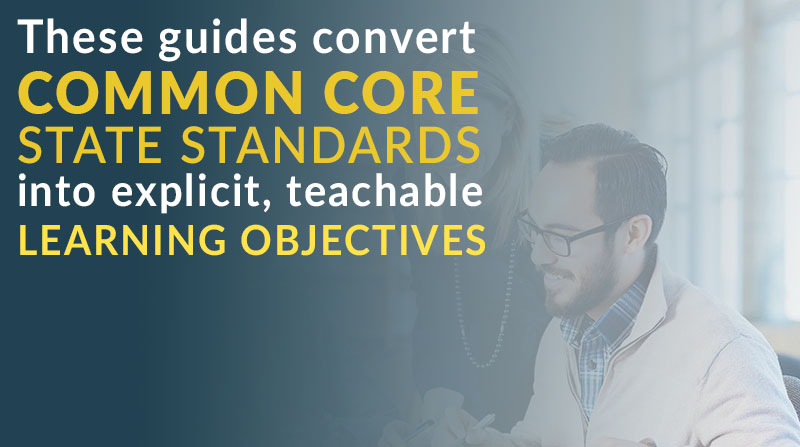Learning Objectives Guides are digital books that help teachers shift from just reading state standards to quickly creating lesson plans that focus on the required skills and content.
Guides are available for Common Core, Next Generation Science, Literacy, and more for K-12 teachers.
Frequently at DataWORKS, we are asked what it takes to craft a standards-based Learning Objective for use in the classroom. As many of you know, Common Core State Standards are often verbose and complex. This presents the problem of creating a concise Learning Objective without sacrificing clarity. In today’s post, we’ll take a look at how to craft a student-friendly Learning Objective from a Common Core Standard.
First, it is important to make the distinction between a content standard and a Learning Objective.
Content standards (such as Common Core State Standards) describe what students are to be taught over the course of a school year.
A Learning Objective is a statement that describes what students will be able to do at the end of a lesson, as a result of instruction.
Perhaps most importantly, a Learning Objective defines the purpose of the lesson, giving it direction from the very start. While it may appear to be a small part of the lesson, a well-written Learning Objective lays the foundation for a great lesson.
Within a Learning Objective, we have a Skill, Concept, and (often) Context.
The Skill of a Learning Objective is the measurable verb, or what the students will be doing. The Concept is the topic or big idea of the lesson, usually being a noun. The Context is the restricting condition of the lesson and may not be present – or may be removed for brevity in lower grades. Focusing on these three components can be useful in decreasing the word count (and cognitive load) of the Learning Objective for students.
To get a better picture of the components of a Learning Objective and its relationship to a standard we can use a simple third-grade example: 
As you can see, there is a considerable amount of language in the standard that would be inappropriate for a third-grade student. We can, however, extract from the standard the three components of a Learning Objective.
For the Skill, we look to the verb – in this case represent – which is what the students will be doing in this lesson.
Once we know the Skill, we can ask a simple question to identify the Concept: “What will our students represent?” The answer, of course, is fractions. The students will represent fractions.
Finally, we look to see if there is a Context, or circumstance, we are limited to. Once again, we can ask ourselves a simple question: “Where or how will the students represent fractions?” The answer here is on a number line. To meet the expectations of this particular standard, students need only represent fractions on a number line – and nowhere else.
Now that we have identified each individual component, we can piece them together to craft our Learning Objective:
The result is a teachable Learning Objective that provides clear, concise direction for the lesson. For the next 50 minutes, students know exactly what they will be doing. Equally important, teachers will set expectations for the lesson and a goal for student achievement which can be objectively measured.
Having trouble coming up with Learning Objectives for Common Core State Standards? DataWORKS has done the work for you!
Check out our Common Core Learning Objectives and Essential Tools Video
Is your school or district crafting Learning Objectives in preparation of implementation of Common Core State Standards? Share your tips or experiences in the comment section below.
Learning Objectives Guides are digital books that help teachers shift from just reading state standards to quickly creating lesson plans that focus on the required skills and content.
Guides are available for Common Core, Next Generation Science, Literacy, and more for K-12 teachers.





